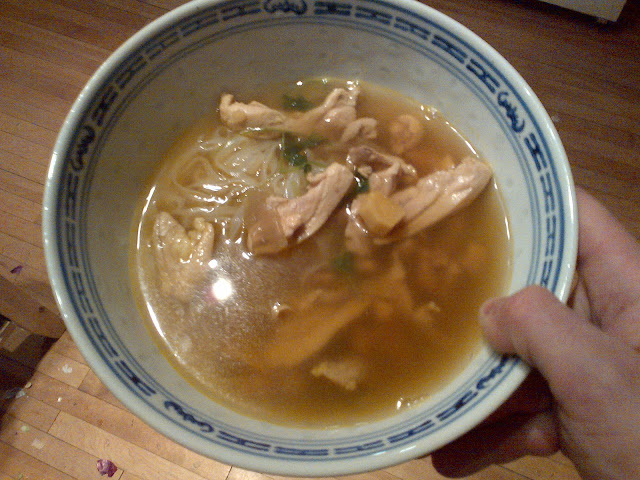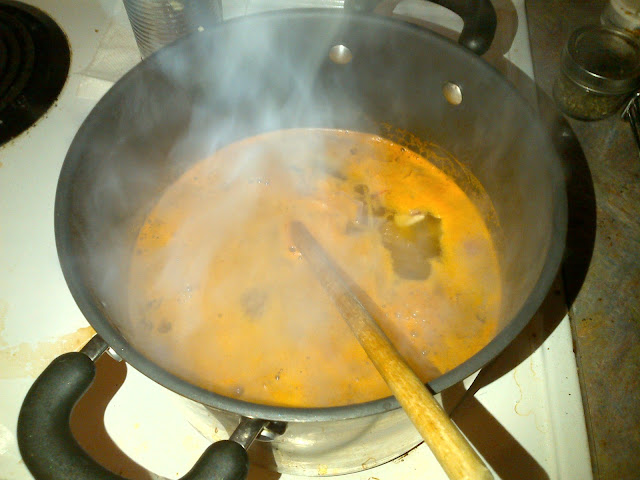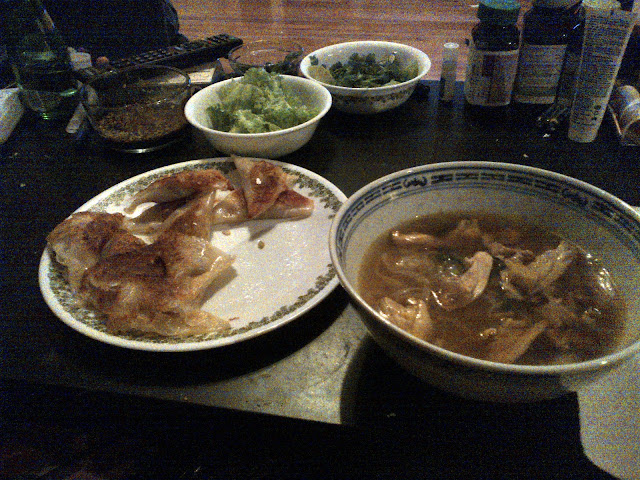Hey there!
I don't know how food trends and realities establish themselves, I really don't; maybe there's the occasional pop culture reference bump. Think The Avengers, where Tony Stark voices his desire, nay NEED, to try Shawarma after beating up ten million aliens. All I could think of was "Oi, go to Marroush on Elgin!" But it got me thinking as to whether or not some foods that are ubiquitous in one city or region might be nearly unknown in others. Is Shawarma uncommon in the U.S., or at least Los Angeles (thinking that Stark's from LA and maybe heard of Shawarma being a New York thing)? Because in Ottawa, it's all over the place. Might have something to do with a large Lebanese population, who knows. Same goes for Donair in Halifax.
In more recent years, however, the ubiquity of the Shawarma joint has been superseded, at least partially, by the Pho joint. It seems like everywhere you go these days, there's a new Pho restaurant opening up! If you happen to head down Somerset Street in Ottawa between Percy and Preston, which is basically our version of Chinatown, you'll come across something like 5362 Pho restaurants. Well, maybe more like 20 to 30. But still! That's a crazy amount of restaurants based on a single dish for a span of a kilometre! What's even crazier is that a lot of them have been in business for over a decade and always seem to be doing good business. Even outside the East Asian section of town, Pho is everywhere.
So, what is it about Pho that makes it so appealing? I honestly don't really know other than the simple fact that it's perhaps one of the most diverse, nourishing and tasty soup concepts ever made. Conceptually, it's fairly simple: a flavourful beef broth (details to come), noodles, some kind of meat or tofu and all kinds of garnishes. Traditionally, it's served with Thai basil, mint, bean sprouts, lime wedges and whatever condiment you prefer (most Pho places I've been to have Sriracha, hoisin sauce, sweet chilli sauce, soy sauce or fish sauce, or some combination of all of these on the table).
Pho is perhaps the essence of Vietnamese cuisine, I've read that it's "Vietnam in a bowl". It was possibly adapted from a French style of stew, possibly not (the Internet is, as always, confusing on the subject). What is a fact is that by the mid-20th Century, Pho was a staple food in Vietnam and after thousands of Vietnamese people left the country over the course of the Vietnam War and moved all over the globe, Pho became widespread as well. Not sure why it didn't catch on in Ottawa as widely till the 90s, but caught on it has! I still remember my first Pho was at a place on Booth Street called New Mee Fung where they serve a kind of spicy Satay-inspired Pho (I guess it might not be actual Pho - not sure what the nomenclature rules are). To this day, it's the best I've ever had. Thanks to my squeeze at the time, Leslie, for introducing me to that!
And so the day came a few weeks ago that Kari and I agreed to try our hands at making our own Pho from scratch, mostly because when she says she has a craving, I listen! So, we trundled out to get groceries and went to work! What we came up with is far from an authentic Pho, rather it's a simplified version. Normally, to make your Pho broth, you'd have to cook down a hunk of beef or bones (one recipe I saw uses oxtail while another uses a combination of beef chuck and marrow bones). We cheated with ours and used a powdered stock. It also cut down the cooking time significantly.
 |
| Now that's a bowl of soup! |
Now, I wanted to make my Pho broth really spicy to help clear up the ol' blocked sinuses. Turns out I went a little overboard and had to spend a good hour adding more water and seasoning to balance out the heat. It added at least an hour to the cooking time and was a general pain in the butt and as such, I won't be recreating the actual recipe as I made it, but rather as it should have been made.
So let's check it out!
Part 1 - Making the broth
Ingredients
- 1 tbsp vegetable or olive oil
- 2 inch piece of ginger, peeled and roughly chopped
- 5-6 cloves garlic, roughly chopped
- 1 litre (4 cups) beef stock/broth - I used the powdered stuff and it was fine, but then I recently read the ingredient list. Yikes. Stick with actual beef stock.
- 1 onion, chopped
- 2-3 stalks celery, chopped
- 2 whole star anise, broken into smaller pieces
- 1/2 tsp cinnamon
- 1/2 tsp allspice
- 1 tbsp fish sauce
- 1 tbsp Sriracha sauce (optional; here's where I screwed up. I squeezed a little too hard and added about 3 tbsp. If you want your soup to be volcanic, use that much)
- 1 Thai chili, seeded and chopped (omit if you want no spice at all)
- 2-3 stalks lemon grass, trimmed and chopped (to trim lemongrass: cut off the "bulb" - basically the bottom inch or so, chop the hard green tops, about 10 cm worth or so, remove the bark-like outer layers until you get to the softer centre and chop, like peeling a woody onion with way more layers)
- 1 bunch cilantro stems, roughly chopped (reserve the leaves for garnish)
- 1 package rice or other other noodles (one package is good for about 4 large bowls of Pho)
- Meat (or non-meat) of choice: beef, chicken, shrimp, tofu. For this recipe, I used about a pound of boneless chicken thighs, sliced very thin.
You can always tweak it as you see fit with the seasoning (many traditional recipes also include cloves, but I find them a bit to strong tasting, so I used allspice instead), but the basic seasoning profile is mainly star anise, ginger and garlic. Well, and beef of course.
 |
| The beginning of "Red Pho" broth. I would later have to adjust everything as to make it edible... D'oh! |
Directions
Ideally, you'll want two large soup pots and a strainer for best results, since straining the broth is the best way to keep the "purity" of the stock and not have to bite on giant chunks of seasonings!
- Heat oil and sauté garlic and onions in a large pot.
- Stir broth and water into pot and bring to a boil.
- Stir in all ingredients except cilantro and meat and bring to a boil for a couple of minutes.
- Reduce heat to medium-low (2-3) and simmer for another hour.
- Once hour has passed, turn up heat back to medium and add cilantro stalks and meat. Continue to boil until meat is cooked in broth. Using a slotted spoon, take out pieces of meat, or do this while straining the stock. Put meat aside.
 |
| Nearing completion |
- Some time during this whole process, you'll want to cook the noodles according to the package and portion them out per serving in a large soup bowl.
- To serve: Portion out noodles and meat into bowl and ladle broth over top until you have as much as you want.
Part 2 - Garnishes
This is the easy part and the kind-of customized part. There are no real rules for what kind of noodles you can use in Pho, but rice noodles tend to be most common. As for garnishes, traditionally, as I mentioned, you go with bean sprouts, mint, Thai basil and lime wedges. Unfortunately, we live in Ottawa in winter and sometimes the availability and quality aren't so good. The bean sprouts that were there were manky as hell so that was a no-go, so we used chopped romaine lettuce instead to recreate the "crunch and fresh" factor the sprouts would have brought. Also, Thai basil is hard to find except at Asian grocers (none of which being handy on this occasion) so we had to use normal basil.
 |
| Setting out garnishes |
- 1 small head Romaine lettuce, roughly chopped
- 1 bunch mint, roughly chopped
- 1 bunch basil, leaves picked
- 1 bunch cilantro, leaves picked (the stems from this bunch will already have gone into the broth)
- 1-2 limes, cut into wedges
- Hoisin Sauce
As mentioned before, you can also have Sriracha, soy sauce, fish sauce, sweet chili sauce and whatever else you feel like saucing up your soup with.
And that's that! A super-tasty Vietnamese soup feast in the making. Of course, in our case, Kari decided to add some Chicken-Celery Pot Stickers into the mix!
 |
| Pho and pot stickers - hellooooo comfort! |
Here's hoping you enjoy this version of Pho, even if it breaks tradition.
Cheers!

No comments:
Post a Comment